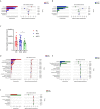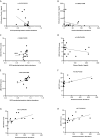Preoperative Microbiomes and Intestinal Barrier Function Can Differentiate Prodromal Alzheimer's Disease From Normal Neurocognition in Elderly Patients Scheduled to Undergo Orthopedic Surgery
- PMID: 33869072
- PMCID: PMC8044800
- DOI: 10.3389/fcimb.2021.592842
Preoperative Microbiomes and Intestinal Barrier Function Can Differentiate Prodromal Alzheimer's Disease From Normal Neurocognition in Elderly Patients Scheduled to Undergo Orthopedic Surgery
Abstract
Objective: Emerging evidence links perturbations in the microbiome to neurodegeneration in amnestic mild cognitive impairment (aMCI) and Alzheimer's disease (AD) and to surgical stress. In this study, we attempted to identify preoperative differences intestinal microbiota (IM) and barrier function between pAD [prodromal AD: Subjective cognitive decline (SCD) and aMCI] patients and normal neurocognition (NC) patients. Additionally, the potential associations between IM and barrier function, inflammation, and the clinical characteristics of pAD were evaluated.
Design: Eighty elderly patients scheduled to undergo orthopedic surgery were consecutively enrolled and grouped as NC, SCD, and aMCI following neuropsychological assessment. IM was determined by 16S rRNA MiSeq sequencing, and PICRUSt was used to predict functional shifts in IM. Furthermore, we investigated the association between IM and plasma claudin-1, occludin, LPS, systemic inflammatory cytokines, neuropsychological assessment, and clinical characteristics.
Results: There was a lower Chao1 index in the SCD group (P = 0.004) and differences in beta diversity among the three groups (PCA: P = 0.026, PCoA: P= 0.004). The relative abundance of Bacteroidetes was higher in the SCD group (P = 0.016, P = 0.008), and Firmicutes were more enriched in the aMCI group than in the SCD group (P= 0.026). At the family level, the total abundance of Gram-negative bacteria was higher in the SCD group than in the aMCI group (P = 0.047), and the Christensenellaceae family was detected at lower levels in the SCD and aMCI groups than in the NC group (P= 0.039). At the genus level, the eleven short-chain fatty acid (SCFA)-producing bacteria exhibited differences among the three groups. PICRUSt analysis showed that the pathways involved in SCFA catabolism, biosynthesis, and adherent junctions were reduced in SCD patients, and lipid synthesis proteins were reduced in pAD patients. Meanwhile, elevated plasma LPS and CRP were observed in SCD patients, and higher plasma occludin in aMCI patients. The IM was correlated with plasma claudin-1, LPS, inflammatory factors, neuropsychological assessment, and clinical characteristics.
Conclusion: The intestines of SCD and aMCI patients preoperatively exhibited IM dysbiosis and barrier dysfunction, and elevated plasma LPS and CRP were observed in SCD patients.
Keywords: elderly patients; intestinal barrier dysfunction; intestinal microbial dysbiosis; orthopedic surgery; preoperative period; prodromal Alzheimer’s disease; systemic inflammation.
Copyright © 2021 Duan, Liu, Fu, Lu and Wang.
Conflict of interest statement
The authors declare that the research was conducted in the absence of any commercial or financial relationships that could be construed as a potential conflict of interest.
Figures







Similar articles
-
Orthopedic Surgery Causes Gut Microbiome Dysbiosis and Intestinal Barrier Dysfunction in Prodromal Alzheimer Disease Patients: A Prospective Observational Cohort Study.Ann Surg. 2022 Aug 1;276(2):270-280. doi: 10.1097/SLA.0000000000005489. Epub 2022 Jun 29. Ann Surg. 2022. PMID: 35766370 Free PMC article.
-
Altered microbiomes distinguish Alzheimer's disease from amnestic mild cognitive impairment and health in a Chinese cohort.Brain Behav Immun. 2019 Aug;80:633-643. doi: 10.1016/j.bbi.2019.05.008. Epub 2019 May 4. Brain Behav Immun. 2019. PMID: 31063846
-
Altered Gut Microbiota in Adults with Subjective Cognitive Decline: The SILCODE Study.J Alzheimers Dis. 2021;82(2):513-526. doi: 10.3233/JAD-210259. J Alzheimers Dis. 2021. PMID: 34024839
-
Subjective Cognitive Decline in Preclinical Alzheimer's Disease.Annu Rev Clin Psychol. 2017 May 8;13:369-396. doi: 10.1146/annurev-clinpsy-032816-045136. Annu Rev Clin Psychol. 2017. PMID: 28482688 Review.
-
Gut microbiome characteristics in subjective cognitive decline, mild cognitive impairment and Alzheimer's disease: a systematic review and meta-analysis.Eur J Neurol. 2023 Nov;30(11):3568-3580. doi: 10.1111/ene.15961. Epub 2023 Jul 30. Eur J Neurol. 2023. PMID: 37399128 Review.
Cited by
-
Distinct gut microbiome characteristics and dynamics in patients with Parkinson's disease based on the presence of premotor rapid-eye movement sleep behavior disorders.Microbiome. 2025 Apr 30;13(1):108. doi: 10.1186/s40168-025-02095-w. Microbiome. 2025. PMID: 40307949 Free PMC article.
-
The possible role of gut microbiota dysbiosis in the pathophysiology of delirium in older persons.Microbiome Res Rep. 2023 May 26;2(3):19. doi: 10.20517/mrr.2023.15. eCollection 2023. Microbiome Res Rep. 2023. PMID: 38046817 Free PMC article. Review.
-
A retrospective study on blood microbiota as a marker for cognitive decline: implications for detecting Alzheimer's disease and amnestic mild cognitive impairment in Republic of Korea.Osong Public Health Res Perspect. 2025 Apr;16(2):141-151. doi: 10.24171/j.phrp.2024.0329. Epub 2025 Mar 24. Osong Public Health Res Perspect. 2025. PMID: 40122583 Free PMC article.
-
Gut Microbiota Alterations in Alzheimer's Disease: Relation with Cognitive Impairment and Mediterranean Lifestyle.Microorganisms. 2024 Oct 10;12(10):2046. doi: 10.3390/microorganisms12102046. Microorganisms. 2024. PMID: 39458354 Free PMC article.
-
Implications of microbe-derived ɣ-aminobutyric acid (GABA) in gut and brain barrier integrity and GABAergic signaling in Alzheimer's disease.Gut Microbes. 2024 Jan-Dec;16(1):2371950. doi: 10.1080/19490976.2024.2371950. Epub 2024 Jul 15. Gut Microbes. 2024. PMID: 39008552 Free PMC article. Review.
References
-
- Baars L. M. A. E., van Boxtel M. P. J., Visser P. J., Verhey F. R. J., Jolles J. (2008). O2-01-03: Is mild cognitive impairment a stable diagnostic entity? Alzheimer’s Dementia 4 (4), T131. 10.1016/j.jalz.2008.05.306 - DOI
-
- Bonfili L., Cecarini V., Berardi S., Scarpona S., Suchodolski J. S., Nasuti C., et al. . (2017). Microbiota modulation counteracts Alzheimer’s disease progression influencing neuronal proteolysis and gut hormones plasma levels. Sci. Rep. 7 (1), 2421–2426. 10.1038/s41598-017-02587-2 - DOI - PMC - PubMed
Publication types
MeSH terms
Substances
LinkOut - more resources
Full Text Sources
Other Literature Sources
Medical
Research Materials
Miscellaneous

